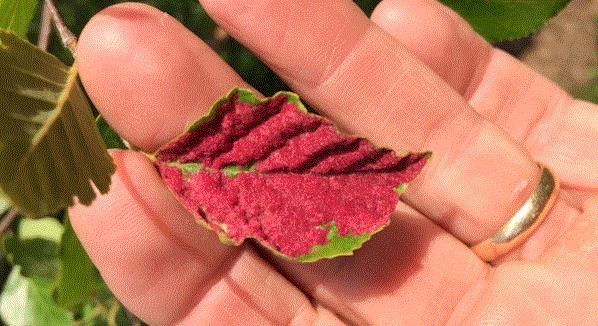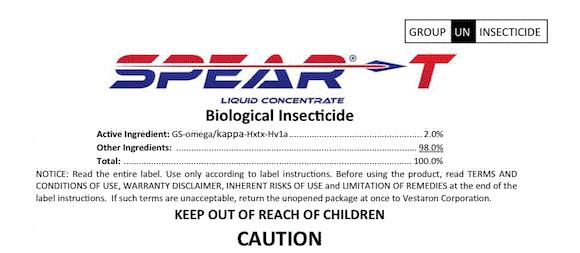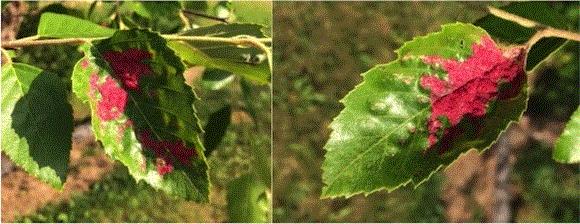What the ... ?
It’s always great to hear from a friend, especially when they come bearing gifts. Cam Lay did just that last week. Cam worked for Clemson University’s Department of Pesticide Regulation and co-hosted a great call-in radio show on insects and other cruds for many years. He came out of retirement and shared a few fascinating pictures from his home in Maine.
What is this pink, velvety fuzz on the river birch leaf? Got a clue? Whether you do or not, read on and find out.

Pests of mums
How are your mums? My crew planted some this week for a few experiments on controlling caterpillars and aphids. Since I’m only growing them as bug food, I could get away with a late start. Folks in the office will be happy to take home a few of the more decent looking ones after I’m done with the experiments.
I’ll take this opportunity to give y’all a list of pests and diseases to watch out for during this mum season.
It hurts my pride as an entomologist to admit that diseases are often bigger problems than insects in mum production. Gary Moorman of Penn State listed 14 diseases of mums by symptoms and causal agents, and provided brief synopses on their management.
Pythium stem and root rot is by far the number one disease problem in operations I’d visited. The chance of having a pythium problem is high if the weather in your neck of the woods is similar to mine, i.e. hot and hotter. One of my responses to heat is to water my plants more frequently. That, in fact, will create an environment (hot and wet) that’s loved by pythium. If your production area has a history of pythium root rot, or the environmental conditions are favorable to disease development, it may be worth your time and expense to consider a preventive drench with fungicides or biological control agents.
Sharing the second place on my "book-of-the-bads" are botrytis, fusarium wilt and bacterial leaf spot.
I’m sure you are familiar with botrytis. This disease is particularly prevalent in humid conditions and damaging at the later stage of production by causing brown spots and rot on flowers and buds. As in other crops, management of botrytis in mums starts with sanitation (clean out dead plants and leaves), and good air circulation and venting. Fungicides are largely preventive and should be applied at the first sign of the disease.
Fusarium wilt can be hard to diagnose. Pay particular attention to plants that are chlorotic, stunted and appear water-stressed. The fungi plug up the vascular system of the plants, interfere with water transport, and cause wilting. Wilting often appears on only one side of the plants, but sometime the entire plant can be wilted. Look further down and you might see discoloration of the stem at the soil line. The infected stem is reddish brown inside. Maintaining medium pH at 6.5 to 7 can help prevent fusarium wilt. Fungicide programs should begin early because the disease is quite difficult to control once it has firmly established itself.
Bacterial leaf spots often show up in operations practicing frequent overhead irrigation, which keeps the foliage wet and helps the bacteria spread and infect. I’ve often seen the leaf spots or necrotic patches developing from the edge of the leaves and starting from the bottom half of the plants. The leaf spots are mushy when wet and brittle when dry; smell a bit funky to me too. If you have bacterial leaf spots, the easiest thing to do is to discard the infected plants. Reduce your irrigation frequency and avoid overhead irrigation to avoid spreading the disease. Copper products may help with preventing disease progression, but they are not silver bullets.
Also, watch out for other diseases: various fungal leaf spots, rhizoctonia, powdery mildew, erwinia blight, white rust, yellow rust, various viruses, viroids and phytoplasmas, and foliar nematode. Detecting them early in their infection cycle often helps with effective management. You can have a less stressful crop if you can deny these diseases their favorite growing conditions.
There is not really a number one insect pest because I’ve seen aphids, thrips, spider mites and caterpillars popping up at seemingly equal frequency. If I HAVE to pick, I would say aphids, especially in the later part of the season. Green peach aphid, melon aphid and chrysanthemum aphid are some of the more common species. Early detection is the key to avoid having the mums covered with honeydew, sooty mold and cast skins. Aphids are not difficult to manage—most registered insecticides are very effective. The key is to find them early, hit them hard and repeatedly, and achieve good spray coverage (since aphids often feed on the underside of leaves). Biological control, especially when using a banker plant system, can be very effective in preventing the aphid population from exploding in your face.
Attacks by thrips cause distortion of the growing tips and abortion of flower buds. They also feed on flowers, causing stippling and discoloration of the petals. Thrips also transmit impatiens necrotic spot virus. Twospotted spider mite is more problematic when it’s hot and dry. They can cause stippling, discoloration and leaf drop. Thrips and mites are very difficult to control, so find them early and use the most effective product to reduce the population.
The most common caterpillar pest of mums in my area is the beet armyworm. Once in a while I’ll find loopers and corn earworms. Do you have leaves cut out from your mums? Did you find worm poops? Do you leave lights on in the greenhouse? Check, check and check, then you might have caterpillars. The caterpillars are usually not very active during the day, so you should look deep inside the canopy or under the pots for worms. Caterpillars are not difficult to control. Some of my early works demonstrated that they could be effectively controlled with our old (such as Scimitar) and new (such as Mainspring) arsenal. Dipel and Thuricide (Bacillus thuringiensis) are very effective against younger caterpillars.
Leafminers used to be the limiting factor in potted mum production. The chrysanthemum and serpentine leafminers haven't been huge issues in my relatively young career—I’ve only received occasional reports of infestations. But don't let your guard down. There are effective management tools against leafminers, but these tools don't work well if you don't find the infestation early.
I hope this is an uneventful mum season for you. If you do get into trouble, check out the 2017 Southeastern US Pest Control Guide for Nursery Crops and Landscape Plantings to find out which insecticide, miticide and fungicide to use against your cruds.

Spear-T available for greenhouse use
Vestaron announced on July 12 that Spear-T, a bioinsecticide, is now available for greenhouse use. Spear-T will be distributed by Isagro USA for the greenhouse vegetable market. Vestaron will announce additional distribution rights for the greenhouse market at a later date.

The active ingredient of Spear-T is GS-omega/kappa-Hxtx-Hv1a. A mouthful, I know. But its history is nothing short of fascinating.
This active ingredient is based on a peptide in the venom of the Blue Mountains funnel-web spider of New South Wales, Australia. Folks at Vestaron identified the genes responsible for producing the peptide. They inserted the genes into yeast and mass produced the peptide in fermentation tanks.
The mode of action of Spear-T is unknown, but earlier studies on various insects and mites suggested that it is likely a neurotoxin. Two potential targets of the active ingredient are a voltage-gated calcium channel and a calcium-activated potassium channel. The intoxicated insects first contract their limbs uncontrollably, lose movement coordination, and finally results in paralysis and death.
Unlike the original venom, which is injected by the fangs of the spider, Spear-T works by contact. Its targets include broad mite, thrips, twospotted spider mite and whiteflies. Additional pests may be added in the future. REI is 12 hours.
Broadform and Exteris Stressgard from Bayer
Bayer officially introduced Broadform at Cultivate’18 on July 16. Broadform is a “7-11” combination fungicide (fluopyram and trifloxystrobin) for foliar disease control. Janna Beckerman of Purdue University and Aaron Palmateer of Bayer shared their experience with Broadform during the launch.
The mirror product of Broadform in the turf market is Exteris Stressgard. Bayer announced on July 10 that Exteris Stressgard is now registered in New York State. Exteris Stressgard is used to manage foliar diseases, such as dollar spot, brown patch and leaf spots, on commercial and recreational turf. Use rates are 1.5 to 12.6 fl. oz. per 1000 sq. ft., depending on disease and pressure.

Answer to the "What the ... ?" mystery
What is that pink, velvety fuzz on the river birch leaf? Did y’all guess some kind of disease or fungal growth? If so, my friend, you are way off-base.
The fuzz is actually a patch of erineum galls created by a species of eriophyid gall mite. Eriophyid mites are tiny (think one hundredth of an inch) and banana-shaped, with two pairs of legs. They are so small that thousands can fit on one leaf. Eriophyid mites, as a group, are usually host specific. I didn't identify this species but I suspect it is a different species from those that cause similar velvety erineum galls on silver maple, viburnum, hackberry and oak.

Eriophyid mites inject toxins (and some species inject viruses) when they feed on leaf tissues. The toxins and viruses can cause abnormal growths on the plants. These abnormal growths may manifest as galls (think erineum galls and maple bladder galls) or rosette (think rose rosette disease).
No reason to treat for these erineum galls. They may look scary to some, but the galls don’t cause any long-term damage to tree health.
To me, they just look freaking cool!






How do y'all like the new mug shot? See y'all next time!

JC Chong
Associate Professor of Entomology at Clemson University
This e-mail received by 24,620 subscribers like you!
If you're interested in advertising on PestTalks contact Kim Brown ASAP!